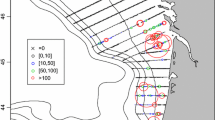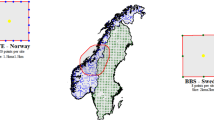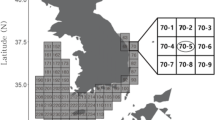Abstract
To get reliable information of the age structure of whale population, Japan conducted a feasibility study of scientific research in the Antarctic in 1987/88. Though the sample was not large enough, it was the first data free from the problem of selectivity and whaling ground bias. From the analysis, it was found that the biological characteristics are highly heterogeneous spatially or other ways. Considering this, we recognize that the survey should be designed to collect the sample from the whole research area uniformly to obtain unbiased estimates of population characteristics. However, in an actual biological field survey, it is difficult to keep the sampling fractions thecisely the same for each sampling units. Therefore, it is important to detect the heterogeneity in the sample, and poststratify the data corresponding to the heterogeneity. The methodology of the estimation and model evaluation presented here will be useful for the development of biological field survey in general.
Similar content being viewed by others
References
Akaike, H. (1973). Information theory and an extension of the maximum likelihood principle, 2nd International Symposium on Information Theory (eds. B. N. Petrov and F. Csaki), 267–281, Akadémiai Kiadó, Budapest.
Akaike, H. (1985). Prediction and entropy, A Celebration of Statistics, the ISI Contenary Volume (eds. A. C. Atkinson and S. E. Fienberg), 1–24, Springer, New York.
Barlow, J. (1990). The utility of demographic models in marine mammal management, Paper SC/42/Mg16 (submitted to the 42nd IWC Scientific Committee, June 1990).
Buckland, S. T. (1985). Perpendicular distance models for the line transect sampling, Biometrics, 41, 177–195.
Buckland, S. T. (1987). An assessment of the performance of line transect models for fitting IWC/IDCR cruise data, 1978/79 to 1984/85, Report of the International Whaling Commission, 37, 277–279.
Burnham, K. P., Anderson, D. R. and Laake, J. L. (1980). Estimation of density from line transect sampling of biological populations, Wildlife Monograph, No. 72.
Butterworth, D. S. (1982). A possible basis for choosing a functional form for the distribution of sightings with right-angle distance: some preliminary ideas, Report of the International Whaling Commission, 32, 555–558.
Butterworth, D. S., Best, P. B. and Hembree, D. (1984). Analysis of experiments carried out during the 1981/82 IWC/IDCR Antarctic minke whale assessment cruise in Area II, Report of the International Whaling Commission, 34, 365–392.
Cochran, W. G. (1983). Sampling Technique, 2nd ed., Wiley, New York.
Cooke, J. G. (1989). Simulation studies of two whale stock management procedures, The Comprehensive Assessment of Whale Stocks: The Early Years (Special Issue 11 of RepReport of the International Whaling Commission (ed. G. P. Donovan)), 147–156.
De la Mare, W. K. (1989). Further simulation studies on management procedures, The Comprehensive As Assessment of Whale Stocks: The Early Years (Special Issue 11 of Report of the International Whaling Commission (ed. G. P. Donovan)), 157–170.
Efron, B. (1979). Bootstrap method: another look at the jackknife, Amer. Statist., 7, 1–26.
Fujise, Y., Kato, H. and Kishino, H. (1990). Reproductive segregation of the minke whale population in high latitudinal waters with some estimations of pregnancy and sexual maturity rates, data from Japanese research takes in 1987/88 and 1988/89, Paper SC/42/SHMI10 (submitted to the 42nd IWC Scientific Committee, June 1990).
Hall, P. (1988). Theoretical comparison of bootstrap confidence intervals (with discussion), Ann. Statist., 16, 927–985.
Hayes, R. J. and Buckland, S. T. (1983). Radial distance models for the line transect method, Biometrics, 39, 29–42.
International Whaling Commission. (1983). Chairman's Report of the 34th Annual Meeting, Report of the International Whaling Commission, 33, 20–42.
Kasamatsu, F., Kishino, H. and Hiroyama, H. (1990). Estimations of the number of minke whale schools and individuals based on the 1987/88 Japanese feasibility study data, Report of the International Whaling Commission, 40, 239–248.
Kato, H. (1982). Some biological parameters for the Antarctic minke whale, Report of the International Whaling Commission, 32, 935–945.
Kato, H., Hiroyama, H., Fujise, Y. and Ono, K. (1989). Preliminary report of the feasibility study on southern minke whale under the Japanese Proposal to the special permit, Report on the International Whaling Commission, 39, 235–248.
Kato, H., Kishino, H. and Fujise, Y. (1990). Some analyses on age composition and segregation of southern minke whale using samples obtained from the Japanese Feasibility Study in 1987/88, Report of the International Whaling Commission, 40, 249–256.
Kate, H., Fujlse, Y. and Kishino, H. (1991). Preliminary analysis on age and reproductive data of southern minke whales obtained from the Japanese research take in 1988/89, Report of the International Whaling Commission, 41 (in press).
Konijn, H. S. (1973). Statistical Theory of Sample Survey Design and Analysis, North-Holland, Amsterdam.
Magnusson, K. G. and Stefansson, G. (1989). A feedback strategy to regulate catches from a whale stock, The Comprehensive Assessment of Whale Stocks: The Early Years (Special Issue 11 of Report of the International Whaling Commission (ed. G. P. Donovan)), 171–190.
Nakamura, T. (1990). A new look at the Bayesian cohort model for time series data obtained from research take of whales, Paper SC/42/SHMi17 (submitted to the 42nd IWC Scientific Committee, June 1990).
Punt, A. E. and Butterworth, D. S. (1989). Results of first stage screening trials for a proposed whale stock management procedure, The Comprehensive Assessment of Whale Stocks: The Early Years (Special Issue 11 of Report of the International Whaling Commission (ed. G. P. Donovan)), 191–198.
Sakamoto, Y., Ishiguro, M. and Kitagawa, G. (1986). Akaike Information Criterion Statistics, Reidel, Dordrecht.
Sakuramoto, K. and Tanaka, S. (1989). A simulation study on management of whale stocks considering feedback systems, The Comprehensive Assessment of Whale Stocks: The Early Years (Special Issue 11 of Report of the International Whaling Commission (ed. G. P. Donovan)), 199–210.
Scott, A. J. and Rao, J. N. K. (1981). Chi-squared tests for contingency tables with proportions estimated from survey data, Current Topics in Survey Sampling (eds.) D. Krewski, R. Platek and J. N. K. Rao, 247–266, Academic Press, New York.
Tanaka, S. (1990). Estimation of natural mortality coefficient of whales from the estimates of abundance and age composition data obtained from research catches, Report of the International Whaling Commission, 40, 531–536.
Author information
Authors and Affiliations
About this article
Cite this article
Kishino, H., Kato, H., Kasamatsu, F. et al. Detection of heterogeneity and estimation of population characteristics from the field survey data: 1987/88 Japanese feasibility study of the southern hemisphere Minke whales. Ann Inst Stat Math 43, 435–453 (1991). https://doi.org/10.1007/BF00053365
Received:
Revised:
Issue Date:
DOI: https://doi.org/10.1007/BF00053365




